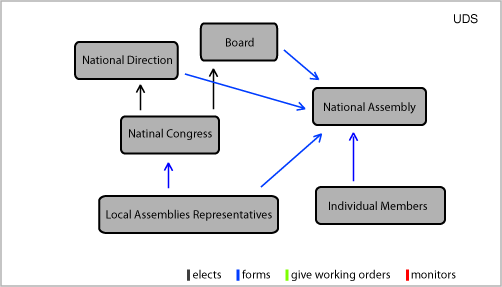url: http://edufile.info/?view=representations&topic=topic_general_infos&country=18&add_tag=-47
Representations Italy
Name
Unione Degli Studenti - UDS
Italian School Students’ Union
Type of Members
Individuals, groups of students and student councils.
UDS is formed by individuals, groups of students and student councils, organised in local, provincial and regional federations.
Amount of members
5 regional federations
8000 students
General Assembly
300
Budget
The total budget is around € 10,000.
Organisation's Staff
None
Year of Foundation
1994
Basic Structure

UDS has five main bodies, the National Congress, the National Assembly, the National Direction, the National Board and the National Coordinator.
The National Congress is the highest decision-making body in UDS. The Congress meets every two years and one of its most important tasks is to elect the Board and the National Direction (for a two-year period). It is made up of delegates elected in local assemblies. The National Assembly is the highest decision-making body in between National Congresses. Apart from representatives from local, provincial and local federations, every individual member taking part in school, local or regional councils where students are represented is invited. The National Direction and the Board also sit in the GA. It meets every three months.
The National Direction manages day-to-day affairs. It is formed by a minimum of 10 elected members, the national board, the national coordinator, regional coordinators and board members of OBESSU who are members of UDS. It can create theme working-groups open also to members who aren’t members of the National Direction.
The Board (elected by the GA and proposed by the former Coordinator) is formed by a Coordinator, an Organisational Secretary, and 3 to 8 chairpersons for specific the working groups.
Other Student Unions
In Italy there are four student unions working at the national level. Apart from UDS, these organisations exist:
- Rete degli Studenti
- Studenti di Sinistra
- Students SX
- Unione degli Universitari - an organisation for university students
There is not a national body where all student organisations convene officially and are recognised by the government. However, UDS and all of these organisations are represented at the “Best representative school students’ organizations Board” a consultative body concerning secondary and vocational education at the Ministry of Education. But the ability to represent is not the main criteria for taking part in this Board. UDS is officially recognized as the most representative student union in Italy.
Student Representations
It is legally stated that every public school or private school receiving subsidies must allow the creation of a student council with two representatives from each class, three or four representatives at the School Board and two representative at the Provincial school students’ Council.
Moreover, each of these schools count on a school board where parents, teachers, students and the principals are represented.
Students at School Level
[missing data]
Students in Municipal or Governmental Bodies
Students are not represented in the municipal, regional and national Bodies, except at the regional and national Youth Forum and The Best representative school students’ organizations Board at the Ministry of Education. Another exception is the Provincial school students’ council that is made up of two representatives from each school of the province. UDS has often been critical towards this institution, although it could be, and sometimes is, a good possibility for students to share and be heard. Often however it has been turned into a political instrument to affirm the power of parties at the school students’ level.
The number of seats reserved for students in bodies as the School boards is far from being proportional, and there is still much more to be done in order to make students’ voice heard in all of these boards and in society in general.
In Italy the place student unions take in society is widely conditioned by regional differences. In a wider perspective, and especially in comparison with other European countries, it can be said that Italian school students have little opportunities for making themselves heard. There is still much to be done.
Success
In November,17th 2006, symbolically on the International Students’ day, after a day of mobilisation in more than 130 cities, The Minister of education signed the “Palazzo Valentini Chart”, from the name of the building of the provincial government in Rome. With this act he formalized his endowment in the creation of a National law on the Right to Study (in Italy it is still a regional competence), the creation of the Students’ Card, the implementation of the Italian Declaration of students’ rights and the promotion of the European one, the extension of that declaration with a focus on vocational students.
Hurdles
A stable and trustable public system for funding of student unions at the national level could surely help a better school students’ representation. On the other hand, good representation is hindered by the limited involvement of media and politicians in school students’ issues and therefore Italian student representatives find it hard to make themselves heard in comparison to other social and political players.
Issues
• Competition between organisations – there are so many youth organisations that have the same aims but they don’t want to co-operate.
• Spreading information – media talks about education and active youth so few that most of the people don’t know anything about these topics. Sometimes big events are held for young people but only few come to them. Then arrangers (e.g. local government) accuse youth that they are passive and not caring.
• Social background – lack of money, bad location (e.g. far from big cities)


